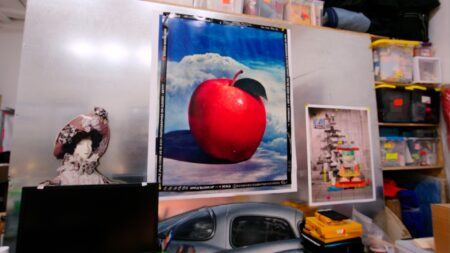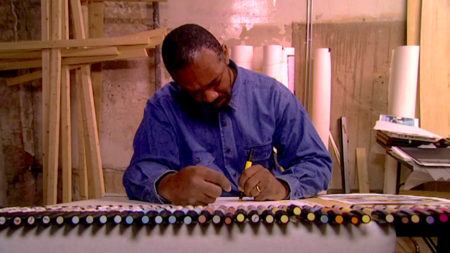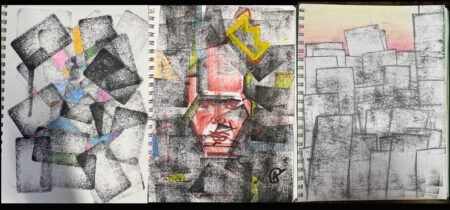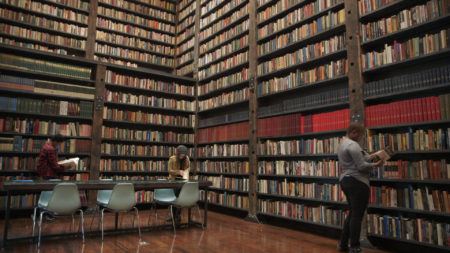Teaching with Contemporary Art
A World Outside of Ourselves: Chinese Diaspora
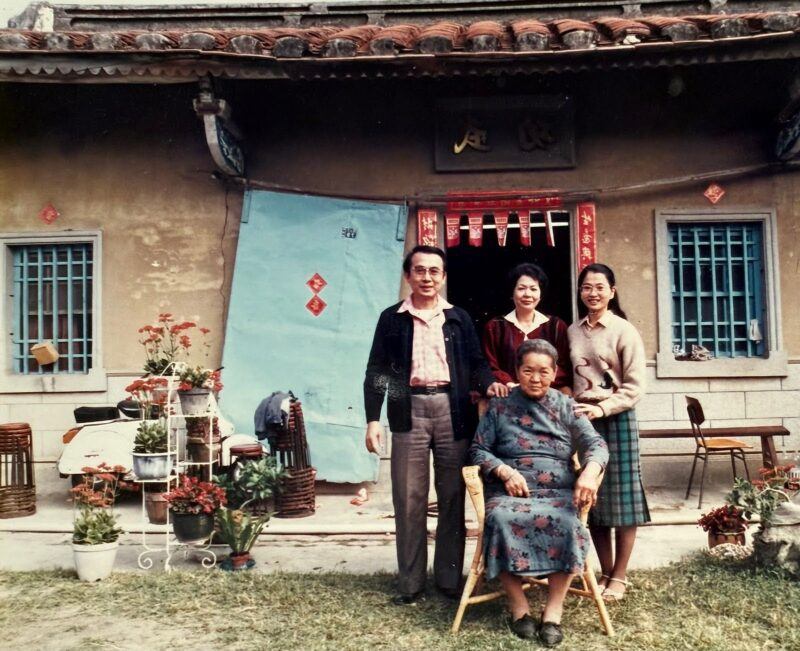
Grandmother’s Home, 1985, Alian District, Kaohsiung, Taiwan. Courtesy of Sasha Spare.
Traveling across the world to Taiwan from an early age offered me an education in the ways of meeting and spending time with extended family, their customs and places of leisure, and their Taiwanese Mandarin language and local dialect. Taiwan is where I first observed the importance of the gift. As a child, I remember receiving so many gifts, endless plates of sliced star fruit and wax apples, gift bags of Taiwanese teas and delicacies, and most memorably personalized red envelopes. Traveling to my grandmother’s house near Kaohsiung, a southern city, showed me a different side of Taiwanese life that in some ways was closer to nature. My grandmother lived and raised her family in a rural and somewhat ancient house surrounded by banana trees. Her house had a painted movable wooden door, a winged rooftop of ceramic tiles, and musty chambers inside. The journey to see my grandmother, the matriarch of our family, required a high speed train from Taipei that passes through mountains and fields. In Taipei, I would walk and bicycle among motorcyclists through humid, tree-lined streets sometimes wet from typhoon rains and always filled with lush plant life, sprawling banyan trees, orchids clinging in unlikely places, and various potted plant collections along window sills, sidewalks, and stoops. Visits to the green cliff sides and pathways of Yangmingshan National Park and the famous marble gorge of Taroko National Park would strip away my usual routine mentalities and everyday objectives and return me to human scale existence within immense nature.
The love of ancestral origin places; the people and customs those places hold and represent; the weight of cross-cultural, intergenerational communication and understanding; and the exciting questions of what each generation chooses to focus on alongside the next must also include an intentional participation within our timing of environmental consciousness at large. Traditions of mutual care among friends and family; haunting cultural silence on inequalities and violence; and simple joys and abilities like collective holidays, the happiness and prosperity of children, and overall human health must not eclipse a much needed return to environmental safety.
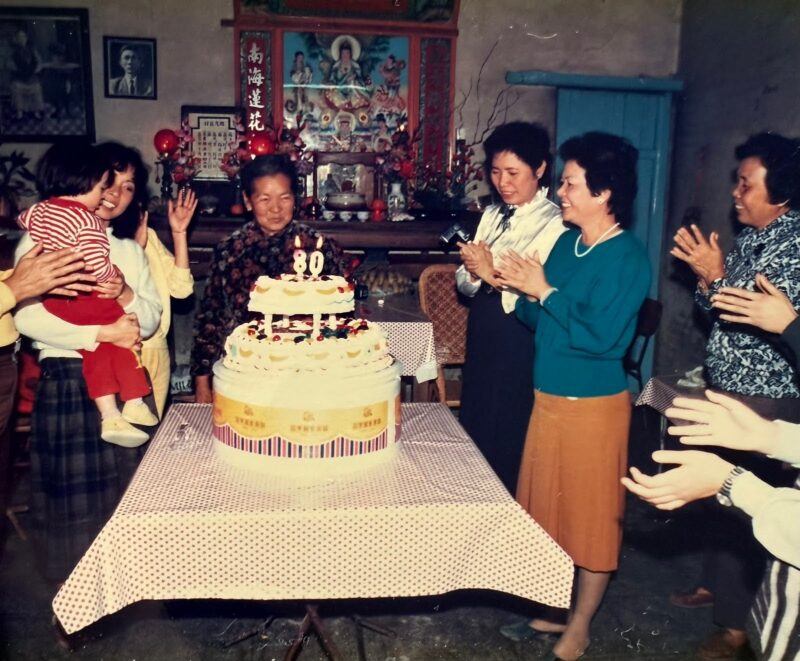
Grandmother’s 80th Birthday / Home Interior, 1985, Alian District, Kaohsiung, Taiwan. Courtesy of Sasha Spare.
Ancient Chinese art reveals an aesthetic of epic fluidity. Geometric patterns wrap edges; inked calligraphic strokes line and dot picture planes; clusters of figures mingle within a scene; curved contours of leaves fill tapestries; rounded lines capture bodies of mythical creatures, wildlife, and human beings; drapery of robes echo stems and flower petals; and the varied representation of what is known as qi, or life force, bestows its presence in paintings, pottery, and bronzes. An attention to environmental consciousness and harmony is spatially woven throughout images within relationships of scale, poetic notions of vast unmeasured space, and equalized amounts of importance among natural elements. Dynastic time is said to be “the most powerful and lasting narrative framework of Chinese art… which organizes historical information and channels the historical imagination through successive dynasties from the third millennium BCE to the twenty-first century CE. …So deep-rooted is this temporal order in Chinese art history that it seems to have become self-evident and natural, as a priori and shared chronology that escapes historical scrutiny” (5, Hung).
After learning about the gold rush or Gum Shan, “Gold Mountain,” Chinese workers traveled to the American west coast and San Francisco to seek out a new land of prosperity. In the 1870s, an anti-Chinese movement gained momentum amongst white communities and laborers as Chinese coal miners accepted work for less pay. In 1882, Congress passed the Chinese Exclusion Act to keep Chinese migrants from entering the United States. Despite this law, Chinese people pushed through. In 1871, eighteen Chinese men were killed in a riot in Eureka, California, and within a few years, 300 Chinese workers were driven out of their living quarters overnight. In 1885, twenty-eight Chinese residents of Rock Springs, Wyoming were killed by a group of white coal miners, fifteen or so were injured, and some permanently damaged. Despite a massacre that filled the town with the stench of burning human flesh, 650 Chinese laborers returned to work in the mines with the enlisted presence of 200 soldiers one week afterward. In 1943, the Chinese Exclusion Act was lifted by Congress, and 105 Chinese immigrants were annually permitted into the United States. In 1965, the 105-person limit was removed, and Chinese immigration was at last equal compared to European immigration (44-53, Luo).
A settlement house that welcomed Chinese families and their children was Telegraph Hill Neighborhood Center (Tel-Hi), founded in San Francisco in 1890 by two American women in their twenties, Elizabeth Ashe and Alice Griffith. They established their mission of strengthening the lives and abilities of local families through educational programs and public health services. When I arrived in 2005, I noticed a sign that noted the two founding pioneers and their mission, then a wheelchair accessible ramp and passageway that led to the center’s entrance. Inside a modest series of spaces for groups of people hosted elderly seniors who enjoyed refreshments in the late morning. At Tel-Hi, designated rooms welcomed around forty elementary age children, offering them sanctuary, endless play, and a studious place to concentrate on homework or practice skills before venturing outside to a playground or a basketball court. After a year of employment at Tel-Hi, I moved to New York City. The memory of our team and neighborhood community has always stayed with me. The ways in which we shared space together helped me realize how to build collaborative relationships with students, how to manage groups, how to design different lengths of programming, how to teach art and craft workshops, how to facilitate field trips to North Beach Branch Library, and how to coordinate with local school teachers with regard to individualized tutoring services in the areas of literacy and mathematics. Art and academic education ideally offers us a multicultural team and a place for being witnessed.
Defining roles in the beginning of my work as a teaching artist were internships that supported a middle school afterschool program that emphasized citizenship and an artist-run summer art program for high school students, and later a teaching assistantship of children’s architecture classes. As extracurricular classes are held among a circle of chairs, in cafeterias, at lunch tables, in borrowed classrooms or offices, in hallways, outdoors, or streamed online, architecture informs our ability. Navigating relationship-building with students and accessing their authentic identities, thoughts, or concerns while guiding methodologies of creativity led me to observe that well-resourced, organized, and stable open spaces encourage social interaction and caliber learning experiences. When a social space is secured, art education is an alternate universe. The cities we build together as a collective are inspired by our ideas of freedom and nurture identities, be they non-binary, transgender, gender fluid, gay, or queer. The model city hot-glued by two best friends in elementary school functions in a bright unfiltered light, a place where families enjoy togetherness and dream together. There is always the draw of designing a dream future and a futuristic dream space: the dream city block, the dream tree house, the dream renovation of the building we currently stand in together, the dream super power, the dream work of art. In this world, we approach everything with a playful eye, looking for liberation and clever twists, designing for our community. Two contemporary artists who exemplify accountability through the social engagement of land and communities are Maya Lin and Mel Chin.
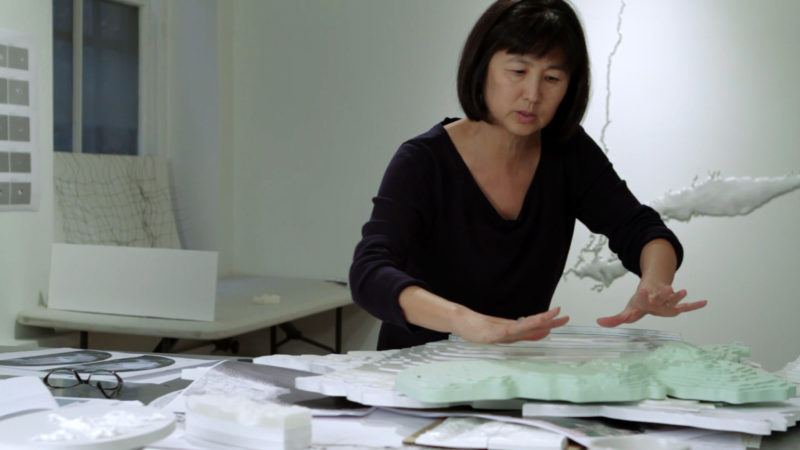
Production still from the Extended Play film “Maya Lin: Disappearing Bodies of Water.” © Art21, Inc. 2013.
Maya Lin, an artist known for her combined art and architecture, embeds remembrance into stretches of land, transforms vacant patches of city space, and retraces nature’s edges with natural materials to heighten awareness about an ever-present need to strengthen local and global ecologies. Born in 1959 to parents who left China near the time of Mao Zedong’s reign, her father a ceramicist and interpreter for the United States Navy in China from 1944–1946, and her mother a poet and professor of American and Chinese literature, Lin grew up in Athens, Ohio in a home environment of coexisting cultures. Lin has referenced her position as a “distanced observer not belonging to one singular place of origin or cultural identity,” which may suggest why she possesses such a strong ability to research other people and in turn create works that educate and radiate empathetic imagination. The significant role of site-specificity in her work coincides with the transformation of vacant spaces and their alternative environmental uses and protections. She likens the desired effect of her work with the experience of reading a book or holding a personal conversation, citing an impact of intimacy. Her aesthetic also parallels qualities of Chinese painting “where space was intended to be at once viewed, traveled through, toured and lived in” and with “a Chinese view of history as cyclical” (60-62, Brenson). With careful considerations of social activity; sensory experience; historical eras; and points of cultural context, Lin has produced land artworks, park design, sculptural exhibitions of land and water elements, a lighted ice-skating rink that mirrors constellations of a night sky, museums and memorials dedicated to diverse histories and cultural groups, and visualized integrations of science and art. To experience Lin’s public artwork, Ghost Forest, a surrealist uprooting of 49 dead Atlantic white cedar trees from the Pine Barrens of New Jersey replanted in Madison Square Park of lower Manhattan, is to pass through a kind of holographic dimension of what a ghost forest is and what its environmental realities look like up close: rising temperatures, extreme weather, saltwater intrusion, forest fires, and invasive insects. Additionally as an act of environmental accountability, Lin calculated the amount of carbon used in Ghost Forest’s installation and planted a thousand trees around New York City to offset emissions by ten fold within ten years. Alongside this public artwork, Lin built and introduced a nonprofit foundation called What is Missing?, an effort to communicate and mobilize ways of reforming relationships to land, biodiversity, protected species, habitat restoration, and the reduction of carbon emissions.
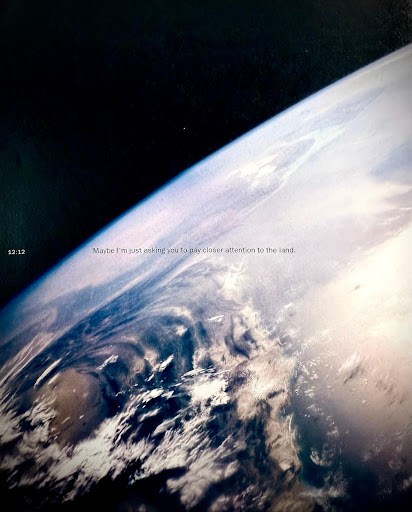
Maya Lin. Boundaries (last page), 2000.
In terms of connecting to realities of climate change and unresolved geopolitical racial inequities, the practice of viewing images and nature documentaries of the planet (what’s left of its sparkling ecosystems and their supply of protections and wonder) is an easy comfort. Lin has asked, “We all know about these far off places, but how many of us will go visit them?” in terms of witnessing complex environments such as the Arctic or the Antarctic. Our relationship to photography and videography of nature is double-edged. We see what we might never see in person and are perhaps both mesmerized and shocked as we comprehend the duality of our most extraordinary ecosystems and our worst natural catastrophes, vividly and remotely. Lin, an avid practitioner of image-based research, expands her view of the world by examining the environment through different perspectives of landscape photography, which includes aerial and satellite images and microscopic and stop camera motion images. She redefines her relationship with environmental consciousness through close interpretations of photographs, which have led her to believe in nature-based solutions such as blue carbon, a process that restores wetlands that offer protection against rising seas, restoring three times as much carbon as a tropical forest. Soil-cleansing results of hyperaccumulator plants is another nature-based solution exhibited in land artworks produced by artist Mel Chin and sourced from the scientific research of Terence McKenner and government agronomist Dr. Rufus Chaney.
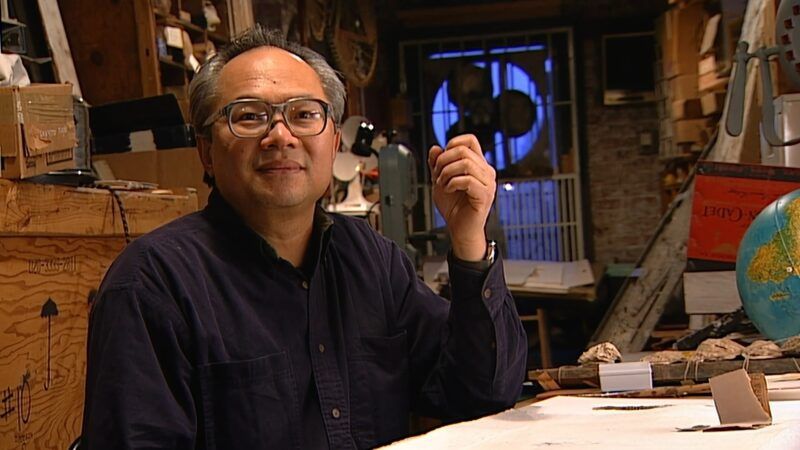
Production still from the Art in the Twenty-First Century” Season 1 episode, “Consumption.” © Art21, Inc. 2001.
Mel Chin, an Asian Texan multimedia artist born in Houston, Texas to Chinese parents in 1951, develops interdisciplinary installations and object-based works of art sourced from eclectic site-specific research and materials. “As a dealer in transformation, [Chin] feels the necessity to create new tools with which to construct, repair, refine, and implement the mechanics of change” (1, Lippard). The value of individuals and revived environmental ecologies are two principles of Chin’s work, in addition to observations about a preoccupation with nationalist attention deficit and its interference with universal human rights. Mel Chin created Schematic drawing for Revival Field in 1990, an image that would envision variations of hyperaccumulator plants that enact phytoremediation – in other words, plants that clean toxic grounds of soil, a process known as hyperaccumulation. Mel Chin identified this process of hyperaccumulation by datura plants a revolutionary basis and sculptural material for depicting pollution removal and a return to ecologically sound land. Revival Field, supported by a grant from the National Endowment for the Arts, is an ongoing land art piece created in 1991 at Pig’s Eye Landfill in St. Paul, Minnesota, a location known for its high levels of extractable cadmium. “The artwork takes a cosmological form: a circle in a square (heaven and earth in Chinese iconography) divided into four quarters by intersecting walkways… [Chin] sees himself sculpting a site’s ecology with science, politics, and economics as the sculpting tools” (9, Herrara). As the first Revival Field, Pig Eye’s Landfill was the field test for the possibility of prototyping this strategy on a larger scale. In 1992, Maquette for Revival Field/Netherlands was created, exhibiting the first replicated Revival Field test for the Netherlands. Revival Ramp made by Chin in 1996, illustrates a spiral ramp with three internalized pathways. One of the roads leads to a crowd of trees after bypassing depictions of an industrial wasteland and an illustration of Revival Field. Revival Ramp and every variation of Revival Field suggests the potential and process of reverse pollution.
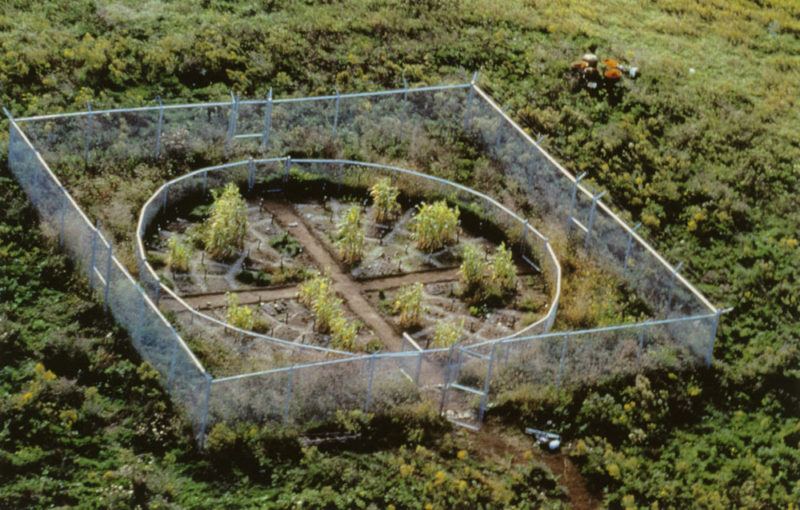
Mel Chin. Revival Field, 1991. Pig’s Eye Landfill, St. Paul, Minnesota. Plants, and industrial fencing on a hazardous waste landfill; approximately 60 × 60 × 9 feet. Courtesy of the artist.
An anchoring legislative framework for climate action and a nationwide source of policy motivation, the Climate Leadership and Community Protection Act passed in 2019 in New York State. This policy mandated zero-emissions electricity by 2024 and an 85% reduction in greenhouse gas emissions by 2050. New York State’s massive overhaul from gas to electric is the result of multilevel collaboration between lawmakers, state agencies, advocacy coalitions, and the broader public. While New York governor Kathy Hochul was a central political leader in pushing for the decarbonization of buildings and transportation and banning natural gas hookups in most new buildings starting in 2026, additional advocacy groups who rally public support and pressure lawmakers are: NY Renews, Rewiring America, Sierra Club’s Building Electrification Campaign, and NY State Energy Research and Development Authority. Sustainable concrete practices in concrete consumption and structure performance is another area of possibility in terms of significant carbon reductions and essential shifts in geotechnical and structural perspectives.
With the same obsessive industry that built railroads, cities, and global economies, what conditions would allow people to practice inclusivity, equity, and accountability in terms of functional design relationships with nature? Imagine a world that is competitive in spirit about protecting natural ecologies, moving away from climate anxiety toward an inventive lifestyle of innovation and sustainable willpower, caring more about people and inhabitants of the wild, connecting accountability and pride with industry, and creating environments where people are comfortable with being seen. Imagine these values and actions having a following similar to that of sports and entertainment. In the same ways that teachers and students wonder what defines global citizenship, how global cooperation is enacted, and what innovation looks like in the 21st century, one might consider the circumstances that would shift linear economic competition to functional relationships that center around safety, accountability, and accessibility. To normalize invested excitement and action around trendsetting in terms of establishing environmental policies, let’s ask ourselves: what do these practices and spaces look like and what values do they require?
To start, Taiwan Design Research Institute located in Songshan Cultural and Creative Park of Taipei, Taiwan includes Taiwan Design Museum and Not Just Library. Taiwan Design Museum currently features an exhibition of educational spaces transformed by renovation across Taiwan while Not Just Library holds a well-lighted library space in which a global collection of design books and publications are accessible for public perusal. Henning Larsen, a global architecture studio and foundation, and Ramboll Group, a global architecture, engineering, and consultancy company, share environmentally conscious principles with artists Maya Lin and Mel Chin. Henning Larsen, a mission-driven company about sustainable society and design was established in 1959. While Henning Larsen commits to principles of sustainable construction, Ramboll Group provides sustainable solutions and knowledge across various sectors such as Buildings, Transport, Energy, Environment & Health, Water, Management Consulting and Architecture & Landscape. Designs, architectures, and services are thoroughly researched, based on site specific local and global responses, exercise deep expertise in material and energy sources, and model accountability in terms of requirements and policies concerning carbon emissions.
